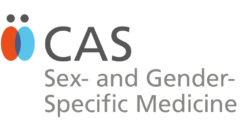Place: Zurich
Language: English
Registration deadline single module: 1 week before module start
Fee: two-day module CHF 500, single-day booking CHF 280
Objectives of the module
Participants
- know the sex-specific pathophysiology and vascular biology in coronary artery disease (e.g. non-obstructive versus obstructive coronary heart disease, microvascular dysfunction, plaque rupture versus plaque erosion) as well as its differential diagnoses (vasospasm, coronary dissection, Takotsubo syndrome).
- are familiar with sex and gender differences in clinical manifestation and treatment of coronary artery disease (Yentl syndrome) and are able to perform a benefit-risk assessment prior to percutaneous coronary interventions in men and women.
- know the different pharmacodynamics and kinetics of cardiovascular drugs in men and women (e.g. anticoagulants, platelet inhibitors, antiarrhythmics, heart failure therapies).
- know about the gender neglect in cardiovascular research (bikini medicine) and the resulting knowledge gaps as well as the consequences for everyday clinical practice.
- know the sensitivity/specificity of non-invasive cardiac stress testing and cardiac imaging in men and women (e.g. breast attenuation artefacts, sex-differences in exercise tolerance, effects of estrogen and testosterone on exercise electrocardiograms)
- know gender differences in heart failure (e.g. heart failure with preserved [HFpEF] versus reduced [HFrEF] ejection fraction), in sudden cardiac death and cardiac arrythmias.
Content of the module
Cardiology is a clear example of a medical field where treatment concepts have been geared to one specific gender. Indeed, a myocardial infarction is still considered a typical male’s disease, although women encounter a heart attack just as often- but on average 10 years later – than men. This age gap is most likely due to the protective effects of estrogens on the cardiovascular system. Although men are at higher risk to suffer a heart attack at a younger age than women, clinical outcomes from a myocardial infarction are currently worse for women than for men. Variables accounting for the higher case fatality rates in women are still largely unexplored and the knowledge gaps are nourished by the persistent underrepresentation of women in cardiovascular clinical trials. Indeed, management strategies and guidelines for coronary artery disease have been largely the same for women and men while derived from predominantly male populations. In addition, it is known that women with an acute myocardial infarction report more often unspecific symptoms and, consequently, experience higher patient and system delays. Also, women receive less aggressive invasive treatment and pharmacotherapies than men (the so-called Yentl syndrome). These disparities persist in contemporary practice, despite studies documenting the reduction of the excess cardiovascular mortality in women when optimal care is provided.
In this module the influence of sex and gender on cardiovascular pathophysiology, clinical presentation as well as on diagnostic and therapeutic strategies and outcomes will be taught. The module comprises the following blocks:
- Epidemiology, global burden of cardiovascular disease, impact of sex hormones/female and male reproductive systems on cardiovascular health, sex-specific myocardial disease, sex- and age-related myocardial changes (CG)
- Sports cardiology (CK)
- Coronary artery disease (BS, CK)
- Valvular heart disease and its therapy (evidence from basic and clinical research) (BS)
- Cardiac arrhythmias, sudden cardiac death (CB)
- Cardiovascular primary prevention: nutrition, physical activity, sex and gender differences in cardiometabolic diseases, sex specificity of new biomarker profiles from OMICS approaches (genome, transcriptome, metabolome and proteome) (EO, TM)
- Cardiovascular diseases in specific risk populations, e.g. in young women and men, patients with inflammatory and infectious diseases (EO, TM)
- Cardiovascular secondary prevention (gender differences in cardiac rehabilitation utilization, risk stratification, and pharmacotherapies) (EO, TM)

